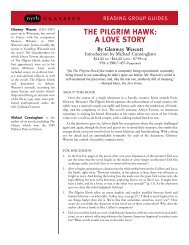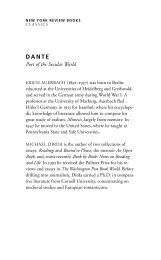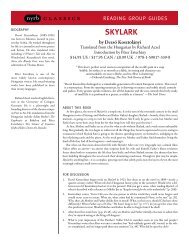Renoir, My Father Introduction - The New York Review of Books
Renoir, My Father Introduction - The New York Review of Books
Renoir, My Father Introduction - The New York Review of Books
Create successful ePaper yourself
Turn your PDF publications into a flip-book with our unique Google optimized e-Paper software.
<strong>Introduction</strong><br />
Among Auguste’s views <strong>of</strong> life that Jean shared is the dislike<br />
<strong>of</strong> “the fast changes in our modern world” which he mentioned<br />
in his letter to Cerf. For both men, materialism, machinery, and<br />
mass production stifle the individual and degrade nature and artistic<br />
quality; it is the “leprosy <strong>of</strong> modern industry” that Jean writes<br />
about when revisiting his father’s sites in Chatou. Nearly every<br />
modern encounter in the book with his father’s painted places and<br />
his family’s former residences makes him lament their former<br />
state. In Provence nowadays, “the little farmhouses, with Mediterranean<br />
tile ro<strong>of</strong>s, have been replaced by apartment buildings <strong>of</strong><br />
reinforced concrete, and the old mill in the valley has become a<br />
night club.” In Montmartre, Jean deplores the loss <strong>of</strong> a garden plot<br />
near his father’s old studio, replaced by an eight-story building.<br />
In his letter to Cerf, Jean said that he would try “to give an<br />
idea <strong>of</strong> my past impressions” <strong>of</strong> the meetings with his father, “and<br />
<strong>of</strong> the way they influence me today.” French Cancan, released two<br />
years after he began the book, shows that influence because it is<br />
a wistful return to the Montmartre <strong>of</strong> his extreme youth (he was<br />
born in 1894) where memory merged with <strong>Renoir</strong>’s paintings. In<br />
Hollywood, where he lived after 1940, his wife Dido’s garden made<br />
him think <strong>of</strong> “Paradou,” the southern garden in Zola’s novel<br />
La Faute de l’Abbé Mouret. He surrounded himself with furniture<br />
and objects from his father’s household, “magic carpets which<br />
take me back to the years I am trying to evoke.” He used his<br />
magic carpets to give delightful accounts <strong>of</strong> Belle Epoque persons<br />
like the actress Jeanne Samary, whom <strong>Renoir</strong> painted long before<br />
Jean was born.<br />
Inserting dialogue as though he and the reader were present,<br />
Jean seems to have scripted his book as if it were a film. He recalls<br />
living after his father’s death on the rue Frochot in a building<br />
which legend says was built by the elder Dumas, and that reminds<br />
him to insert his father’s thoughts about Dumas. From the same<br />
apartment on the rue Frochot he could see the building where<br />
Jeanne Samary lived. He imagines her leaning out the window, or<br />
doing her morning marketing on the rue Lepic. “She must have<br />
carefully felt the melons to see if they were ripe, and looked with a<br />
critical eye at the whiting to make sure it was fresh.”<br />
It would be foolish to object to these cinematic flashbacks, because<br />
the appeal and the value <strong>of</strong> Jean <strong>Renoir</strong>’s book is in his imag-<br />
viii






